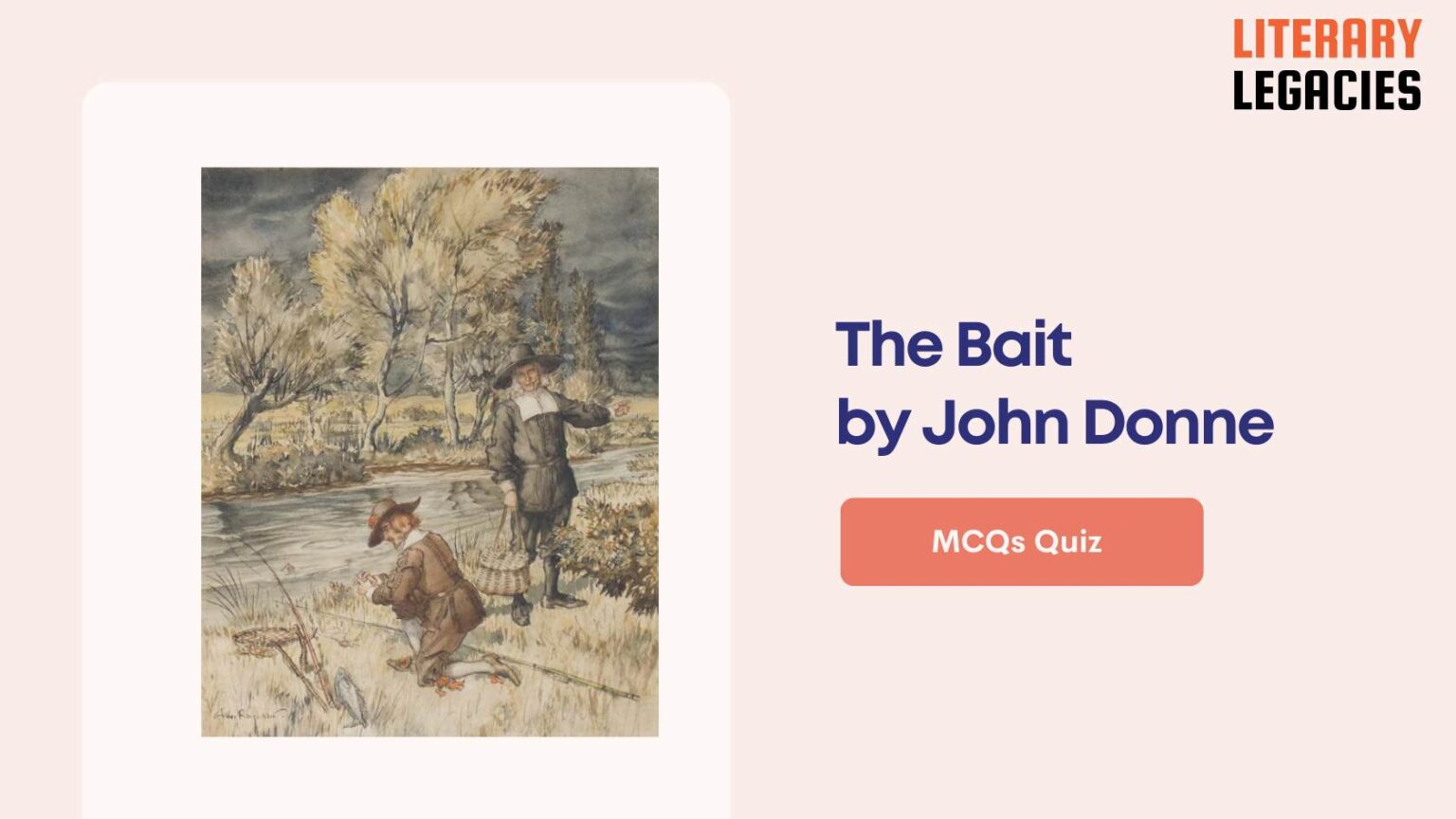1. What is the speaker’s request to the object of his affection in the poem?
A. To go on a picnic
B. To go fishing with him
C. To take a stroll by the river
D. To come live with him and be his wife
Answer: To come live with him and be his wife (D)
The speaker invites the beloved to come live with him, implying marriage.
2. What is the indirect way the speaker describes the allure of his beloved?
A. Describing fish in pools and brooks
B. Singing a love song
C. Comparing her to a rose
D. Writing a love letter
Answer: Describing fish in pools and brooks (A)
The speaker describes fish in pools and brooks to indirectly describe the allure of his beloved.
3. What will happen to the fish if the beloved enters the water?
A. They will die
B. They will hide in the depths
C. They will follow her
D. They will swim away
Answer: They will follow her (C)
The speaker says that if the beloved enters the water, the fish will follow her.
4. How does the beloved attract others, according to the speaker?
A. By singing a siren’s song
B. By deceiving them
C. Honestly, as her own bait
D. By using bait
Answer: Honestly, as her own bait (C)
The speaker says the beloved is her ‘own bait’, honestly attracting others to her.
5. What does the poem show about Donne’s ability?
A. His ability to fish
B. His ability to take a standard form and apply it to a traditional spiritual metaphor
C. His ability to swim
D. His ability to write a love poem
Answer: His ability to take a standard form and apply it to a traditional spiritual metaphor (B)
The poem shows Donne’s ability to take a standard pastoral form and apply it to a traditional spiritual metaphor.
6. What is the traditional subject of a pastoral poem?
A. A fisherman
B. A farmer
C. A shepherd or outdoorsman
D. A sailor
Answer: A shepherd or outdoorsman (C)
Traditionally, pastoral poems focus on a shepherd or another land-based outdoorsman.
7. What replaces sheep and green fields in Donne’s poem?
A. Mountains and rivers
B. Cities and buildings
C. Fish and sparkling water
D. Trees and flowers
Answer: Fish and sparkling water (C)
In Donne’s poem, sparkling water and fish replace the traditional pastoral subjects of sheep and green fields.
8. What is the rhyme scheme of each stanza in the poem?
A. baba
B. abab
C. abba
D. aabb
Answer: aabb (D)
Each stanza in the poem follows an aabb rhyme scheme.
9. What is the speaker’s attitude towards the beloved by the end of the poem?
A. Admiring
B. Indifferent
C. Respectful
D. Wiser than himself
Answer: Wiser than himself (D)
The speaker concludes that any fish that can resist her charms is wiser than himself.
10. What topic does the speaker shift to by the end of the stanzas?
A. The outdoors
B. The beloved’s beauty
C. Fishing hooks
D. Sand and brooks
Answer: Fishing hooks (C)
The speaker changes the topic from sand and brooks to fishing hooks by the end of the stanzas.
11. What is the spiritual meaning of the conceit in the poem?
A. The beloved is a symbol of nature
B. The beloved is a representation of worldly desires
C. The beloved is a symbol of beauty
D. The beloved is Jesus, who is the fisher of men
Answer: The beloved is Jesus, who is the fisher of men (D)
The connection to Jesus as the fisher of men helps readers understand the rest of the poem.
12. What is the effect of the beloved’s eyes in the second stanza?
A. They make the water cold
B. They blind the fish
C. They make the water ‘Warm’d by thy eyes, more than the sun’
D. They repel the fish
Answer: They make the water ‘Warm’d by thy eyes, more than the sun’ (C)
The beloved’s eyes have a profound effect on the environment.
13. What do the fish represent on the physical level?
A. Men who do not care about the woman’s beauty
B. Men who are afraid of the woman’s beauty
C. Men who are indifferent to the woman’s beauty
D. Men who are taken by the woman’s beauty
Answer: Men who are taken by the woman’s beauty (D)
The fish are drawn to the beloved’s beauty, just like men are drawn to a beautiful woman.
14. What is the beloved’s method of drawing in her prey?
A. Through false promises
B. Through deception or cruelty
C. Through her natural beauty
D. Through harsh conditions
Answer: Through her natural beauty (C)
The beloved’s natural goodness is what draws men to her.
15. What is the poet’s comparison of himself to?
A. A wise fish that escapes the beloved’s charms
B. A bird that flies away from the beloved
C. A flower that blooms in the beloved’s presence
D. A fish that is caught by the beloved’s charms
Answer: A fish that is caught by the beloved’s charms (D)
The poet sees himself as one of the fish caught by the beloved’s charms.
16. What is the worldly analog to the false baits used by fishermen?
A. Cruel or deceptive men
B. Promiscuous or deceitful women
C. Honest and faithful women
D. Kind and gentle people
Answer: Promiscuous or deceitful women (B)
The worldly analog is promiscuous or deceitful women who use deception or artifice to win a man’s love.
17. What is the spiritual analog to the false baits used by fishermen?
A. Spiritual leaders who guide people to God
B. Honest preachers who tell the truth
C. Demagogues or false preachers who deceive or make false promises
D. True preachers who make false promises
Answer: Demagogues or false preachers who deceive or make false promises (C)
The spiritual analog is demagogues or false preachers who deceive or make false promises to gain followers.
18. What is the poet’s conclusion about the beloved in the final stanza?
A. She needs no deceit to attract men
B. She needs deceit to attract men
C. She is too beautiful to deceive
D. She is too cunning to deceive
Answer: She needs no deceit to attract men (A)
The poet concludes that the beloved ‘need’st no such deceit’ to attract men.
19. What is the poet’s attitude towards the beloved at the end of the poem?
A. He is deeply in love with her
B. He is envious of her power
C. He is critical of her methods
D. He is indifferent to her charms
Answer: He is deeply in love with her (A)
The poet is deeply in love with the beloved and cannot imagine anyone escaping her charms.
20. What is the tone of the poem?
A. Mysterious and symbolic
B. Overtly sensual and passionate
C. Literal and straightforward
D. Metaphysical and spiritual
Answer: Metaphysical and spiritual (D)
The poem is a metaphysical poem that uses symbolism to convey its point about the purity of the beloved and, by extension, the purity of one’s love for God.
21. What is the speaker’s intention in using the metaphor of fishing?
A. To illustrate the process of falling in love
B. To reveal the beloved’s cunning nature
C. To express the speaker’s desire to be caught by the beloved
D. To describe the beauty of nature
Answer: To express the speaker’s desire to be caught by the beloved (C)
The speaker uses the metaphor of fishing to convey the idea that the beloved is the one who has the power to attract and capture others.
22. What is the significance of the ‘live bath’ in the poem?
A. A place where the beloved can be found
B. A symbol of the beloved’s inner beauty
C. A place where the speaker can relax
D. A location where the speaker can fish
Answer: A symbol of the beloved’s inner beauty (B)
The ‘live bath’ is a metaphorical place where the beloved’s beauty and charm are on full display, and where the speaker longs to be immersed.
23. What is the role of the ‘inamor’d fish’ in the poem?
A. They represent the speaker’s friends
B. They are examples of the speaker’s fishing skills
C. They symbolize the beloved’s beauty
D. They are captivated by the beloved’s charm
Answer: They are captivated by the beloved’s charm (D)
The ‘inamor’d fish’ are depicted as being enchanted by the beloved’s presence, and serve as a metaphor for the way others are drawn to the beloved’s beauty and charm.
24. What is the speaker’s attitude towards the methods used by other fishermen?
A. Admiration for their skill
B. Envy of their success
C. Indifference to their methods
D. Disdain for their deceitfulness
Answer: Disdain for their deceitfulness (D)
The speaker expresses disdain for the deceitful methods used by other fishermen, implying that the beloved’s beauty and charm are more effective and honest ways to attract others.
25. What is the significance of the line ‘For thou thy selfe art thine owne bait’?
A. The speaker is saying that the beloved’s beauty is the key to attracting others
B. The speaker is suggesting that the beloved is a fish
C. The speaker is saying that the beloved is a skilled fisherman
D. The speaker is implying that the beloved is deceitful
Answer: The speaker is saying that the beloved’s beauty is the key to attracting others (A)
The line emphasizes the idea that the beloved’s beauty and charm are what attract others, and that no external means are necessary to catch them.
26. What is the overall tone of the poem’s language and imagery?
A. Formal and reserved
B. Playful and whimsical
C. Sensual and seductive
D. Dark and ominous
Answer: Sensual and seductive (C)
The poem’s language and imagery are characterized by a sensual and seductive tone, which is used to convey the speaker’s desire and attraction to the beloved.



